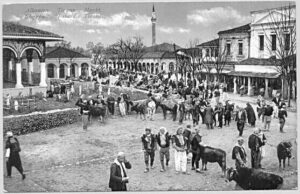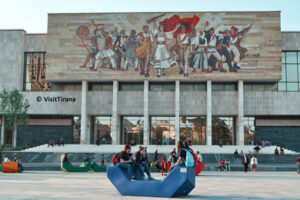The history of Tirana’s architecture
Tirana is a unique city, as all civilizations have left their traces. The first traces of life in Tirana start from the ancient period, when the Illyrian ruins are still in the heart of Tirana, in the part of the Tirana Castle, and where the Academy of Sciences is located today. So, the date is the 5th century BC.
Next, we have the Mosaic of Tirana, the third century of our era, a rustic villa with a floor decorated with geometric motifs.
Ottoman period (1430-1900)
This is the best-known period of old Tirana in the photo, where a large market dominated where today the Palace of Culture is located, the Karapice Mosque, the Church in which a 15-story building was later built, the old City Hall where later made the Historical Museum, meanwhile, the whole street of Durrës has been inhabited with characteristic old houses as well as the part behind the 9-story buildings. The Mosque of Ethehm Bey and the Clock Tower have arrived in our days from the Ottoman period. Also, Kapllan Pasha Tomb is located opposite the Hotel Plaza. The characteristic houses of the Ottoman period were two-story, with large courtyards and gates, surrounded by massive walls. The distinctive symbol of the houses of this period is the Sarajet building (1833) of Selim Pasha Toptani, with 32 rooms of oriental style and beautifully decorated.

Fascist period (1920-1944)
Skenderbej Square, the government buildings, and the entire Deshmoret e Kombit Boulevard up to the University is the extent that the city took at the beginning of Tirana as the capital, i.e., after February 11, 1920, when the entire government moved to Tirana. This remains Tirana’s most authentic and beautiful part, and the architecture is still on all the city postcards.
In addition to the buildings starting from the City Hall, the Central Bank in the Center, and all the other government buildings along the boulevard, during this time, many other villas, two or three stories, were built, such as Vila Petrela, Sali Shijaku, Radio Tirana, Writers League, etc.


The communist period
Communism did not destroy Ottoman symbolism or Italian architecture. But it interfered with the Soviet-style architecture, with many identical five-square-meter buildings along all the main roads, such as Durres Street, where many villas were demolished, the 15-story buildings that took the place of the Church, or the 9-story buildings, which destroyed the villas of the rich, and the palace of culture that destroyed the old bazaar. New neighborhoods were built, but in the same style, where the apartments for citizens were small, with two or three rooms, no more, but the outdoor areas were broad, like public spaces where children played. The iconic buildings of communism are the Palace of Culture, the National Museum, the Congress Palace, the art gallery, and the Pyramid. As well as several monuments, busts, and statues.



Modern period (1990-now)
Tirana has changed so much that even the locals no longer recognize it. Tirana is getting a different look with multi-story buildings and business centers that are rising and flocking mainly in the city center. This means the construction will continue, and Tirana has not yet received a final form. Instead of building new neighborhoods, all the changes are happening again in the center, but without touching the few ruins that are the most significant traces of the previous four periods. Today, the main buildings of Modern Tirana are Air Albania Stadium, Toptani Center and all the buildings that follow the Toptani pedestrian street, the Towers behind the Palace of Culture and the 15th Floor, the giant towers near the Bank of Albania and front of the Orthodox Cathedral. Religious buildings such as the Orthodox Cathedral and the new Mosque on Rruga e Elbasani, which are massive, have been added to this high-rise architecture. Likewise, the structured Pyramid can be called a modern project, even though the structure is that of communism.
Maybe that’s why Tirana is so attractive to foreigners: it keeps changing yearly and doesn’t have a specific physiognomy like any other world capital. Tirana has many cultures, which is evident and surprising to anyone who visits the city.


Other News to Read
Tirana Photo Festival 2025- Mediterranean
The Tirana Photo Festival 2025 took place from June 18 to 30, 2025, in Tirana, with the theme…
What to do in July in Tirana
Welcome July! It’s time to dive into the essence of summer: Tirana is the best destination for this…
Sofra e Tiranes – the capital’s traditional festival
For 31 years, Sofra e Tiranes has been a highly anticipated event in the Tirana community.
International Tirana Photo Festival 2025 –Mediterranean
International Tirana Photo Festival 2025 –Mediterranean, 8th edition, from 18 to 30 June 2025